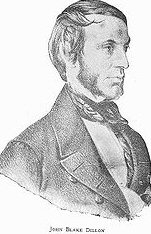In the early 1840s there was much political discontent and turmoil all over Europe. Kings, emperors and aristocrats, returned to power after Waterloo, were facing growing unrest and even open rebellion. The popular ideas of liberty, equality and fraternity …
… of the French Revolution had spread and now Italians, Germans, Poles and a host of other peoples were demanding national self-determination. In Ireland many educated professional young men were in tune with this and looking to their own country’s future.
Thomas Davis, son of an English surgeon and an Irish mother was smitten with this romantic nationalism and he combined with two other like-minded young men, John Blake Dillon and Charles Gavan Duffy to work within O’Connell’s Repeal Movement to attain their object. They founded The Nation newspaper in October 1842 and it quickly outsold all others, its readership (perhaps a quarter of a million) being many times its sales as it was distributed through Repeal reading rooms. Davis called his group Young Ireland in imitation of Giuseppe Mazzini’s Young Italy. Soon they were joined on the editorial board by a fiery journalist (cum solicitor/author/pamphleteer) John Mitchel of Newry.
The paper carried many inspirational nationalist songs written by Davis and popular even today, such as A Nation Once Again and The West’s Awake. Another Newry man John Kells Ingram contributed a song in tribute to the United Irishmen of the previous generation ‘Who Fears to speak of Ninety-Eight?’ The young Ingham, of 35 Hill Street, attended Mr Lyons School in the town from 1829-1837 and became acquainted with Mitchel and his brother-in-law John Martin who was also a Young Irelander. Another of that School and prominent Young Irelander was John O’Hagan who as a solicitor at the bar later ably defended Gavan Duffy when the latter was on trial in 1846.
They were joined by other nationalist leaders such as John O’Leary, Kevin Izod O’Doherty, Michael Doheny, Patrick O’Donoghue, James Fintan Lalor, Terence McManus, Thomas Francis Meagher, Father Kenyon, Devin Reilly and John Edward Pigot. and also by many women including several members of the Mitchel family. Also significantly by landlord William Smith O’Brien (who had a considerable public profile and who was to lead the 1848 Young Irelander Uprising) and John Stephens, John O’Mahoney, [Fenian Brotherhood of 1860s in America] John O’Leary and John O’Reilly who were to make an inestimable contribution to the history of Irish Republicanism a decade or so later).
Despite (or perhaps because of) their education, none was acqauainted with military strategy and, when their thoughts finally turned to insurrection, they seemed to rely on a hoped-for spontaneous uprising of the people against the Government. However while still operating within the Repeal Association it appears that Davis, Dillon and Doheny promoted O’Connell’s Monster Meetings with the object of treating the whole exercise as the training of people in military movements.
At first Young Ireland included in their number monarchists and landlords and were loathe to raise the ‘land issue’, but as Mitchel in particular became more aware of the plight of Irish labourers, cottiers and farmers, the attitudes and policies of Young Ireland took a radically different turn.
… more later …
